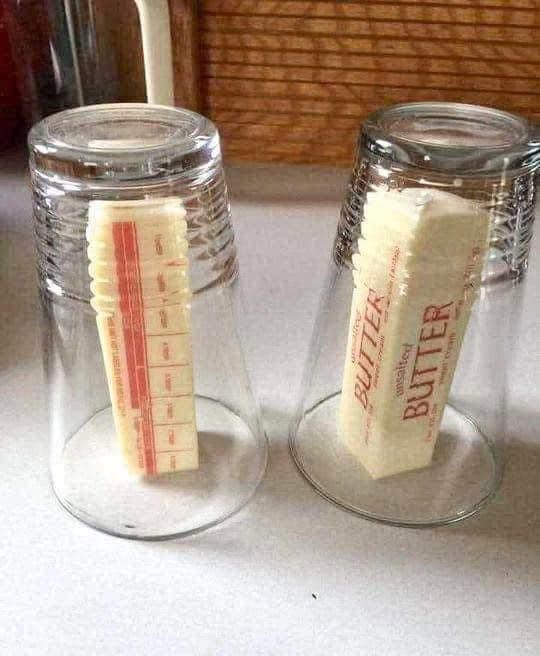- 1 stick of cold butter (straight from the fridge)
- A glass (any sturdy glass works)
- Boiling water (just enough to fill the glass)
- Boil Water: Start by boiling some water—just enough to fill the glass. You want it hot, but you don’t need it to be a huge amount.
- Warm the Glass: Pour the boiling water into the glass and let it sit for a minute or so. This will heat the glass up completely.
- Dump the Water: Carefully dump the hot water out of the glass (make sure to hold the glass with a towel or use caution so you don’t burn yourself). The glass should now be warm, but not too hot to handle.
- Cover the Butter: Flip the warm glass upside down over your stick of cold butter. Make sure the glass covers the butter completely, so the warmth can gently soften it.
- Wait a Few Minutes: Leave the glass on top of the butter for about 3-5 minutes. The heat will gradually transfer to the butter, softening it perfectly. You’ll have butter that’s soft enough to spread, but not melted—just how you need it for baking!
- continued on next page
ADVERTISEMENT
ADVERTISEMENT
Quick Butter Softening Trick: The Glass Over Butter Method
This is one of the simplest, most effective ways to soften butter quickly, and it’s a game changer for anyone who bakes often. You’ll need only two things: boiling water and a glass. Sounds easy, right? Let’s walk you through it.
What You’ll Need:
Step-by-Step Instructions:
ADVERTISEMENT
Why This Trick Works:
You might be wondering—why does this work so well?
The science behind this trick is simple. When you heat the glass, it holds the warmth, creating a little “oven” effect for the butter. This gentle heat gradually softens the butter without melting it. The softened butter is essential for most baking recipes, like cookies, cakes, and frosting, because it helps to create that perfect texture and consistency.
This method is faster than waiting for the butter to soften naturally on the counter, and it’s better than microwaving, which can sometimes cause the butter to melt unevenly and mess up your recipe.
When Should You Use This Trick?
Baking: When you’re making cookies, cakes, or pastries that call for softened butter (not melted).
Frosting: If you’re whipping up a batch of frosting, softened butter is crucial for smoothness and consistency.
Spreads & Toppings: Softened butter is great for spreading on toast, muffins, or scones, or for mixing with herbs and spices to make compound butter.
continued on next page
ADVERTISEMENT
ADVERTISEMENT
Bonus Tip: The Right Consistency
The goal is softened butter, not melted butter. You should be able to press your finger into the butter and leave an indentation, but it shouldn’t be greasy or overly runny. If it’s too soft or starting to melt, you’ve gone too far, and it might affect your baking results.
For most recipes, the butter should be at room temperature, which is around 65°F (18°C). This method gives you that same soft consistency in a fraction of the time.
Other Ways to Soften Butter (if You’re Out of Time!):
While the glass method is a favorite for many bakers, there are a few other tricks you can use if you’re in a bind:
Microwave (on low): If you’re really pressed for time, microwave the butter on low in 5-10 second intervals. Keep a close eye on it so it doesn’t melt.
Grate It: If you’re in a hurry and don’t mind a bit of extra effort, use a box grater to grate the butter into small pieces. It will soften faster because the smaller pieces are exposed to air.
Cut It into Small Cubes: If you have a few minutes, cut the butter into small cubes. The increased surface area allows it to soften faster.
Final Thoughts:
This butter-softening hack is one of those little kitchen secrets that can make a big difference in your baking routine. It’s so simple yet super effective! No more waiting for butter to soften on the counter for hours or risking melting it by mistake.
Next time you’re whipping up your favorite treat, try this trick, and you’ll have perfectly soft butter ready to go in minutes—without compromising your recipe.
ADVERTISEMENT
ADVERTISEMENT
